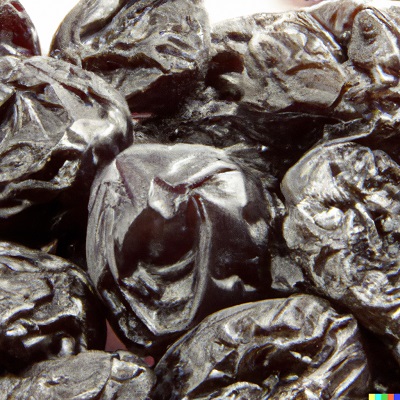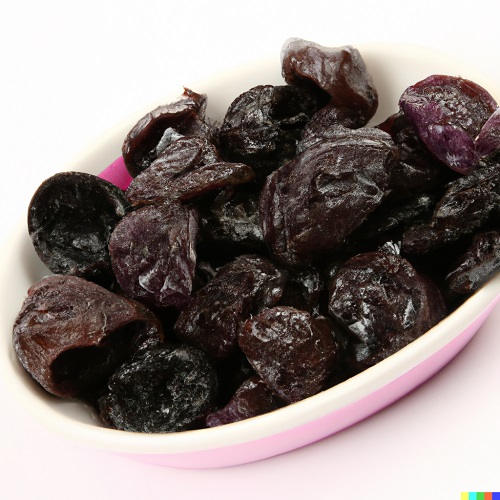
Prunes have been popular for centuries due to their many health benefits and their versatility in cooking and baking. Prunes are dried plums and have a sweet and chewy texture. They are a great source of dietary fiber, antioxidants, and many essential vitamins and minerals, making them a nutritious and delicious snack.
Nutritional Benefits of Prunes
Prunes have been around for centuries and have been used for their various health benefits. They are high in fiber and are known to be very beneficial for digestion. Prunes also contain antioxidants that can help reduce inflammation in the body and may even help to prevent certain types of cancer. They are an excellent source of vitamins, minerals, and energy-boosting nutrients.
The most well-known benefit of prunes is their ability to promote healthy digestion. Prunes are loaded with natural fiber, which helps to keep the digestive system moving properly. This can help to reduce constipation and maintain regularity. Fiber is also important for helping to reduce cholesterol levels and aiding in weight management.
Prunes are also high in antioxidants, which can help to combat free radicals in the body and reduce inflammation. The antioxidants found in prunes can help to protect against certain types of cancer, such as colorectal cancer. Additionally, the antioxidants can help to improve the health of skin and hair and fight off signs of aging.
Prunes are also a great source of essential vitamins and minerals. They are high in vitamins A, C, and K, as well as iron and potassium. Vitamin A is important for eye health, while vitamin C helps to maintain the immune system. Vitamin K is important for blood clotting and iron is essential for energy production. Potassium helps to regulate blood pressure and keep the body hydrated.
In addition to being high in essential nutrients, prunes are also a great source of energy-boosting nutrients. Prunes are high in natural sugars, which can help to provide a quick energy boost. They are also a good source of iron, which helps to transport oxygen to the cells and keep the body feeling energized.
History of Prunes
The history of prunes dates back centuries and this humble dried fruit has been used in many forms throughout its long history. Prunes have been a part of the human diet for a long time and offer a rich array of health benefits.
The term “prune” is derived from the Latin prunum, which means plum. The first use of prunes dates back to the Ancient Greeks, who used them for medicinal purposes. The Romans used prunes to make a type of fruit preserves, which was a popular delicacy and was often served as a dessert.
In the Middle Ages, prunes were a popular food and were used to make a variety of dishes, such as puddings, pies and stews. Prunes were also used to make sweet wines, mead and brandy. Prunes were also an important source of vitamins and minerals during this time.
Prunes had a resurgence in popularity in the 16th century, when they were exported to the New World. In the early 1800s, a French doctor named Jean-Pierre Goyette developed a technique for drying prunes and this process was used to make prunes more shelf-stable and easier to transport.
The first prunes we know today were introduced in the 1880s by Louis Pellier, a French horticulturist. Pellier developed a new variety of prune, which was sweeter and plumper than traditional prunes. This new variety of prune quickly became popular and was soon grown all over the world.
In the United States, prunes were popularized in the 1920s, when they were marketed as a healthy and convenient snack food. During the Depression, prunes were a popular and affordable food option. They were also used in recipes such as fruit cake, cobbler and prune whip.
Prunes are a healthy and versatile food option and can be used in a variety of recipes. They are high in fiber and contain a variety of vitamins and minerals. Prunes are also a good source of antioxidants and are believed to have anti-aging properties. Prunes are also believed to aid in digestion and can help to regulate blood sugar levels.
Today, prunes are consumed in a variety of ways. Prune juice is a popular beverage, and prunes are used in many recipes, such as prune cake, prune jam, and prune pudding. Prunes can also be used in savory dishes, such as stews and soups.

Cooking with Prunes
Cooking with prunes is a great way to add natural sweetness, texture, and nutrition to your dishes. Prunes are a versatile, delicious fruit that can be used in both sweet and savory dishes. They have a soft, chewy texture and a sweet, earthy flavor that lends itself well to a variety of recipes.
When selecting prunes, make sure to choose those that are soft, plump, and dark in color. Avoid those that are shriveled or have signs of mold. Prunes should be stored in an airtight container in a cool, dark place, away from direct sunlight.
One of the most common ways to use prunes is in baking. They can be added to breads, muffins, cakes, and pies to add sweetness and texture. Prunes are also great for making jams and jellies, as well as compotes and chutneys. For a simple treat, try this easy prune and apple crisp. All you need is some cooked prunes, apples, sugar, cinnamon, butter, and oatmeal.
If you’re looking for something savory, prunes are also a great addition to savory dishes like stews, roasts, and soups. They can be used as a natural sweetener and thickener, as well as adding a unique earthy flavor. For a healthy dinner option, try this recipe for braised pork chops with prunes and onions. The sweetness of the prunes gives this dish a great depth of flavor.
Prunes are also great for snacks and salads. Try adding chopped prunes to your favorite trail mix for a sweet and healthy snack. Or make a simple prune and walnut salad, with a few sweet additions like honey and dried cranberries.
Clinical Studies on Prunes
One study found that eating prunes regularly may help reduce the risk of type 2 diabetes. The study followed over 7,000 adults over the age of 50 for 15 years. Participants who ate more than two servings of prunes per day had a lower risk of developing type 2 diabetes compared to those who ate fewer. The authors concluded that regular consumption of prunes may help protect against type 2 diabetes.
Prunes may also be beneficial for cardiovascular health. A study in Japan found that regular consumption of prunes was associated with a lower risk of coronary heart disease. Participants who ate more than two servings of prunes per day had a lower risk of developing coronary heart disease than those who ate fewer.
The antioxidants in prunes may also help protect against certain types of cancer. A study in the journal Nutrition and Cancer found that eating prunes regularly was associated with a lower risk of colorectal cancer.
In addition to the potential health benefits of prunes, they may also be beneficial for weight management. A study in the journal Obesity found that eating prunes regularly was associated with a lower body mass index (BMI). The authors concluded that the high fiber content of prunes may help promote weight loss.
Prunes may also be beneficial for gut health. A study in the journal Nutrients found that regular consumption of prunes was associated with improved gut health. The authors concluded that prunes may help increase the diversity of beneficial bacteria in the gut and improve digestion.